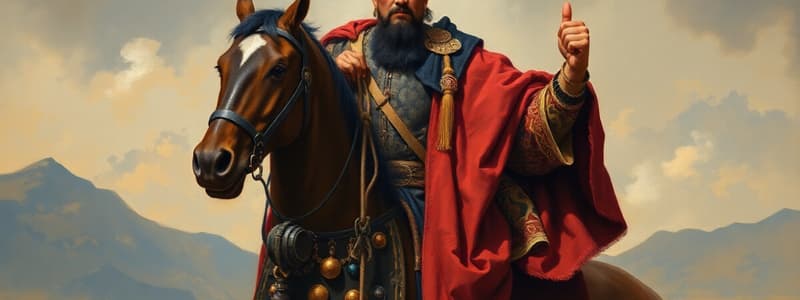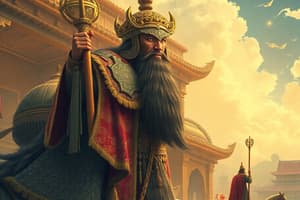Podcast
Questions and Answers
Which empire is considered the largest united land empire in history during its height?
Which empire is considered the largest united land empire in history during its height?
- The Roman Empire
- The Mongol Empire (correct)
- The Ottoman Empire
- The British Empire
Genghis Khan is often depicted negatively due to his extreme violence and conquests.
Genghis Khan is often depicted negatively due to his extreme violence and conquests.
True (A)
What is the birth name of Genghis Khan?
What is the birth name of Genghis Khan?
Temujin
Genghis Khan had at least ___ official wives and over ___ concubines.
Genghis Khan had at least ___ official wives and over ___ concubines.
Match the significant details about Genghis Khan with their descriptions:
Match the significant details about Genghis Khan with their descriptions:
What was Tagin's initial reaction after the surprise attack from the rival Merket tribe?
What was Tagin's initial reaction after the surprise attack from the rival Merket tribe?
Tagin became known as Chingis Khan after he united the tribes of Mongolia into the Great Mongol Nation.
Tagin became known as Chingis Khan after he united the tribes of Mongolia into the Great Mongol Nation.
How many horsemen did Tagin gather to rescue Borte from the Merket?
How many horsemen did Tagin gather to rescue Borte from the Merket?
Chingis Khan distributed ______ of the spoils of conquest to his subjects after capturing Jong du.
Chingis Khan distributed ______ of the spoils of conquest to his subjects after capturing Jong du.
Match the following events to their corresponding outcomes:
Match the following events to their corresponding outcomes:
What was a key factor in the effectiveness of the Mongol cavalry?
What was a key factor in the effectiveness of the Mongol cavalry?
The Mongol bow had a shorter range than the English Longbow.
The Mongol bow had a shorter range than the English Longbow.
What method did Mongol warriors use to prepare their food while riding?
What method did Mongol warriors use to prepare their food while riding?
Match the following Mongol Empire concepts with their descriptions:
Match the following Mongol Empire concepts with their descriptions:
What was one method used by the Mongols to instill fear in surrounding towns?
What was one method used by the Mongols to instill fear in surrounding towns?
The Mongols emphasized loyalty within family units by mixing relatives in different army units.
The Mongols emphasized loyalty within family units by mixing relatives in different army units.
What was the basic building block of Chinggis Khan's army?
What was the basic building block of Chinggis Khan's army?
The distance between postal stations in the Mongol postal system was typically ______ miles.
The distance between postal stations in the Mongol postal system was typically ______ miles.
Match the following terms with their definitions:
Match the following terms with their definitions:
Flashcards
Arbon
Arbon
A military unit consisting of 10 warriors in Genghis Khan's army.
Yagon
Yagon
A military unit of 100 warriors in Genghis Khan's army, formed by 10 Arbons.
Mingan
Mingan
A military unit of 1,000 warriors in Genghis Khan's army, formed by 10 Yagons.
Tumon
Tumon
Signup and view all the flashcards
Utoy (Yam)
Utoy (Yam)
Signup and view all the flashcards
Mongol Horse Stamina
Mongol Horse Stamina
Signup and view all the flashcards
Amble Gait
Amble Gait
Signup and view all the flashcards
Composite Bow
Composite Bow
Signup and view all the flashcards
Mongol Bow Range
Mongol Bow Range
Signup and view all the flashcards
Mongol Deception Tactic
Mongol Deception Tactic
Signup and view all the flashcards
Mongol Empire's size
Mongol Empire's size
Signup and view all the flashcards
Who was Genghis Khan?
Who was Genghis Khan?
Signup and view all the flashcards
Genghis Khan's Wives
Genghis Khan's Wives
Signup and view all the flashcards
Secret History of the Mongols
Secret History of the Mongols
Signup and view all the flashcards
Mongol Nomadic Lifestyle
Mongol Nomadic Lifestyle
Signup and view all the flashcards
Temujin's Early Life
Temujin's Early Life
Signup and view all the flashcards
Temujin's First Murder
Temujin's First Murder
Signup and view all the flashcards
Borte's Kidnapping
Borte's Kidnapping
Signup and view all the flashcards
Temujin's First Great Victory
Temujin's First Great Victory
Signup and view all the flashcards
Temujin's Rise to Power
Temujin's Rise to Power
Signup and view all the flashcards
Study Notes
Genghis Khan: Life and Legacy
-
Genghis Khan, born Temüjin, was a 12th-century Mongol leader who rose from a powerless position to become one of history's most feared conquerors.
-
Western media often portrays him negatively, emphasizing horrific acts like mass murders, while also highlighting his rapid rise to power, unification of Mongolia, and the creation of a vast empire (12 million square miles).
-
His empire stretched from the Pacific to the Mediterranean, encompassing about 1/5 of Earth's landmass, surpassing the Roman and Alexander the Great empires in size.
-
Genghis Khan's name is often misrepresented in English-speaking countries. The correct pronunciation and transliteration of his name is Chinggis Khan.
-
A 2003 study suggested that over 16 million men today may carry a Y chromosome linked to Genghis Khan, implying a significant genetic legacy. Scientific certainty is lacking due to a lack of his DNA.
Early Life and Rise to Power
-
Genghis Khan's early life was marked by hardship and violence. The Mongol nomadic lifestyle demanded constant movement.
-
Childhood omens, a murder, and further fratricides shaped his personality and led to a path of conquest.
-
The kidnapping of his wife Borte ignited his drive for revenge and sparked his military career. This act motivated his growth to power, as he was able to acquire followers and military success.
Military Strategy and Tactics
-
The Mongol army leveraged cavalry, utilizing smaller but incredibly strong and durable horses. Mongol horses were famed for their stamina, speed, and maneuverability.
-
Composite bows, smaller yet powerful with long range, were a key component of the Mongol military's power.
-
Tactics included surprise attacks, skilled use of terrain, and sophisticated organizational structure. Units of 10 Warriors (Arban) and larger squads fostered loyalty and control efficiency.
-
The system of rapid horse-riding messengers (Yam) supported communication and logistical efficiency across the vast empire and facilitated trade.
Expansion and Conquest
-
Genghis Khan consolidated Mongol tribes and formed the Mongol Empire, then expanded west.
-
The sacking of cities like Beijing and those in Central Asia, e.g. the slaughter of 1.7 million people in Nishapur and 2.4 million in Harat, accompanied his conquests.
-
The Mongol invasion of the Khwarazmian Empire was sparked by the execution of a Mongol caravan, with the infamous execution of the Khwarazmian governor highlighting Genghis Khan's ruthlessness.
-
The use of siege tactics and relentless pursuit of enemies further contributed to the vast expansion of the empire.
Cultural and Social Impact
-
Genghis Khan fostered religious tolerance where faith was not an issue for his conquered people.
-
The Silk Road was revitalized under the Pax Mongolica, opening trade routes and communication between East and West.
-
The establishment of a sophisticated postal system, the Yam, significantly improved communication speed and efficiency.
Death and Legacy
-
Accounts vary widely about Genghis Khan's death and succession.
-
His death sparked a period of succession struggles as he didn't explicitly designate a successor, leading to the division of the Mongol Empire.
-
The immense impact of the empire, its eventual disintegration due to internal conflict, and the role of the Bubonic Plague in its decline, are part of Genghis Khan's complex legacy.
-
The plague likely spread along trade routes established or strengthened amidst the Mongol Empire, and potentially through deliberate Mongol actions targeting rival cities.
-
The massive Mongol Empire's sheer geographic scope, coupled with the sheer speed of its political and military advancements, are part of his enduring fascination.
Studying That Suits You
Use AI to generate personalized quizzes and flashcards to suit your learning preferences.




